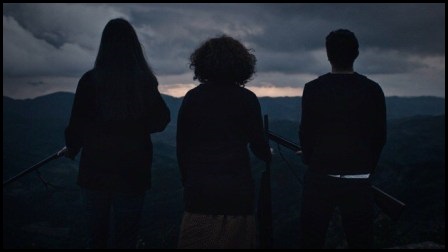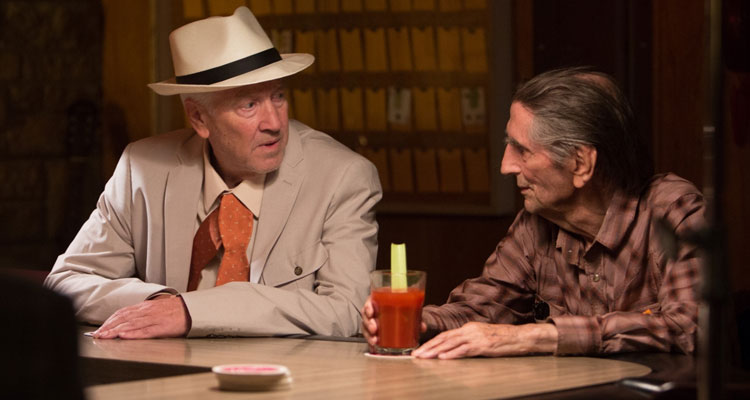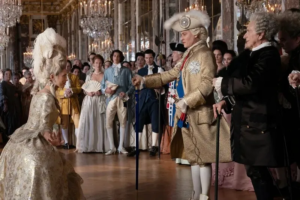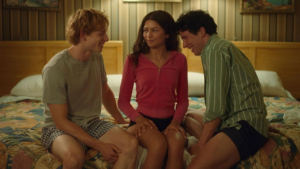ALL FILMS REVIEWED BY GREG KING
LAST UPDATED AUGUST 18, 2017
THE BELKO EXPERIMENT.

The Stanford Prison Experiment meets Battle Royale?
Belko is a US non-profit organisation based in Bogota in Colombia, which works to facilitate American businesses wanting to operate in South America. One day though an unusually high level of security seems to be visible around the high rise office building. As the employees go about their business, a wall of steel shutters surrounds the building and a mysterious voice suddenly comes over the PA system and informs the staff that there are 80 people inside. They have thirty minutes in which to kill two employees or else there will be consequences. Panic erupts temporarily until CEO Barry Norris (Tony Goldwyn) tries to calm them down. When they fail to meet the deadline, over a dozen employees are killed by explosive devices implanted in their heads. The employees had initially been told that they were tracking devices in case of kidnapping, which is a very real danger in this area. Then the remaining employees are told that they have to start killing each other in order to survive. Some people appear only too eager to kill, leading to a violent breakdown of normal behaviour and carnage ensues as colleagues quickly turn on one another. Only one person can emerge victorious.
This twisted premise has been written by James Gunn, better known for his work on the recent Guardians Of The Galaxy films, and marks a return to his roots in low budget horror. The Belko Experiment also sees director Greg McLean return to the gory horror of Wolf Creek, although here the material is suffused with a strong streak of anarchic black humour. The film’s premise gives a whole new meaning to the term cutting back staff, and a range of office equipment is effectively employed in the carnage. The blood splattered scenario delivers plenty of tension and gross out gory moments, and McLean makes good use of the claustrophobic confines. The film has been nicely shot by cinematographer Luis David Sansans (Days Of Grace, etc), and slickly edited by Julia Wong (X-Men: The Last Stand, etc).
McLean has assembled a strong ensemble cast of familiar faces here and audiences will be left to wonder who will survive. Some of the thinly drawn characters though come across as stereotypes. The cast includes Goldwyn (from Ghost, etc) as Norris, who has a background in the military; John C McGinley as the creepy Wendell Dukes; Michael Rooker as a maintenance man; Owain Yeoman (from tv series The Mentalist, etc); Sean Gunn as Marty, the office stoner who provides some comic relief; ; Adria Arjona, Melonie Diaz and John Gallagher jr as the confident and charming Mike, who is the moral compass of the group and tries to urge calm and clear thinking. He is also a likeable hero that we can all root for as all hell break loose.
This twisted and gory thriller plays out as a corporate variation on the Japanese film Battle Royale combined with the psychological manipulation of the infamous Stanford Prison Experiment, with elements of The Hunger Games, Lord Of The Flies, et al. This gore fest delivers a high body count and is something of a perverse pleasure.
BLOODLANDS.

An Albanian family find themselves caught up in a blood feud when they fight against a mysterious clan of witches and cannibals. Bloodlands explores the concept of the system of self-imposed law and eye for an eye justice that is a part of Albania’s ancient culture, where families live under the threat of retaliation and retribution. An earlier film from Albania, The Forgiveness Of Blood, also tackled this theme and depicted the effects of this bloody cycle of revenge.
The film is set in a rural village in a remote mountain region of Albania, a raw and run-down community in the grip of poverty and hopelessness. Skender (played by Gezim Rudi, a popular Albanian actor and one of the country’s biggest stars) is a local butcher who works in the abattoir with his teenaged son Artan (Emiljano Palili), but the family is struggling financially. Then a run in with a couple of homeless people behind the slaughterhouse leads them into a feud. Skender’s patriarchal rule over his family falters under this threat from outside and he has to try and hold the family together.
This Albanian/Australian co-production about a blood feud is the sophomore feature from Australian writer/director Steven Kastrissios, whose previous film was the tough revenge thriller The Horseman a decade ago. While Bloodlands lacks the brutality and graphic violence of that film it is still pretty tough stuff and there are some moments that are not for the squeamish. Bloodlands has been something of a passion project for Kastrissios and it underwent a long post-production period. He mixes this story of revenge with elements of the supernatural here as the centuries old myth of the Shtriga, an ancient and powerful witch, also plays into this drama.
The film was shot on location in Albania, and the bleak setting is matched by the bleak visual style of the production. Cinematographer Leander Ljarja has shot the film in a muted steely blue palette which gives it a cold look and feel, and suffuses the material with a palpable air of foreboding. However, the film was also shot on a shoestring budget and its limitations show through the simple sets and limited locations.
Without the luxury of extensive reshoots or lengthy takes, some of the performances come across as amateurish. Apart from the veteran Rudi, most of the cast are largely unknown and making their film debuts here. There was a kernel of a good idea here, but the script needed more work and a couple of drafts to make it stronger. Many of the characters are underdeveloped, and they needed to be more fully developed and realised so that the audience could sympathise with them and their plight.
Bloodlands captures an Albania casting aside its archaic rituals and past and moving forward into the new century. Nonetheless this is a film that lacks broad appeal, although it could do well on the festival circuit.
LUCKY.

Ninety-year old Harry Dean Stanton delivers one of his finest performances in this low key and unassuming little independent drama that is an existential meditation on mortality and death and the things we leave behind. Johnny Cash’s song I See Darkness further reinforces this theme of death.
This likeable shaggy dog story follows the eponymous Lucky (played by Stanton) on a spiritual journey. He lives in his small one-bedroom house on the edge of town, and we follow him through his daily routine – a bit of yoga, his tv game shows, his walks through the sleepy little desert town he calls home, and his nights in the local bar where he chats with some of the town’s eccentric locals.
The role of Lucky was written especially for Stanton by first time writers Logan Sparks and Drago Sumonja, and the droll performance from the veteran actor, who is on screen the whole time, carries this allusive tale through its brisk 90 minutes. His hangdog expression, weary and haggard look and taciturn nature capture the personality of this loner. The supporting characters are also well-drawn.
Lucky is the directorial debut for actor John Carroll Lynch, and he maintains an unhurried pace throughout. He draws good performances from his cast, which includes film director David Lynch as Howard, who worries about his tortoise which has escaped from his backyard. The cast also includes Beth Grant as Elaine, the brassy waitress who works in his local bar, Tom Skerritt (who appeared with Stanton in Alien) as a WWII veteran, James Darren (from the Gidget movies of the 60s) as a barroom philosopher, and Ed Begley jr as Lucky’s doctor.
Lucky also seems to revisit the territory of Stanton’s 1984 film road movie Paris, Texas, which was directed by Wim Wenders. The arid locations which have been evocatively captured by cinematographer Tim Suhrstedt (Little Miss Sunshine, etc) and Stanton’s performance here will strongly resonate with audiences who remember that film.



